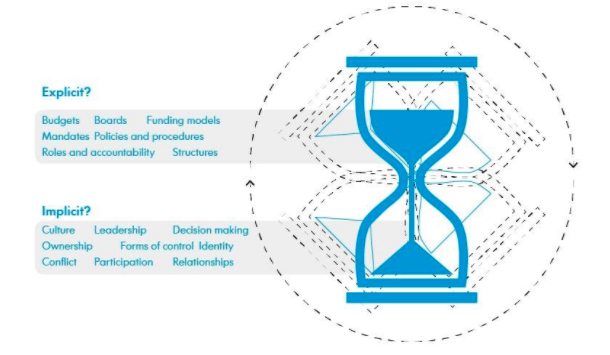Part three in a series of four exploring the future of how we govern and organise. This time, we explore how people think governance happens today and challenge five commonly held governance myths.
Co-written by Sean Andrew, Louise Armstrong and Anna Birney
*If you’re arriving at this blog fresh, you might want to read our first piece on how we organise for change as it provides some context about our governance inquiry.
The past 18 months of living and working in a global pandemic have unravelled many assumptions we used to hold, including of how we organise and work together. As we continue to traverse and transition through this new normal landscape we will cross thresholds that give us the opportunity to reconstellate the structures and patterns that make up how we organise.
Through our governance inquiry we have been learning what elements of governance people experience in organisations and also how people believe governance plays out or works in change making efforts.
This piece shares what we heard about how people think governance happens today and challenges five commonly held myths. Myths tell us what beliefs, assumptions and worldviews we’re working from.
“A myth is something that explains the world; it is, mysteriously, bigger than itself.”
Charles Eisenstein
So as we carry myths of the past to the present, what myths and assumptions might we need to let go of and what might we let come? By sharing and unpacking these myths we can explore what may be holding us back from reimagining governance as an area for transformational change.
You’ll see that some myths are more developed than others. Our intention is to share this as a contribution to a wider conversation, to get people thinking and to come back to these to add some examples and even debunk them if we find them to be no longer true.

Myth #1
Today’s myth: “Let’s find the perfect model”
Myth reimagined:“Start with the context and build from there”
Through our inquiry, we heard people repeatedly ask for a perfect governance model to copy, plug in and press play. Unfortunately, this rarely works. Sure, there might be some structural and technical parts of how we organise where best practice works, but this isn’t like changing parts in a car. We are working with living organisational and organising systems. Living systems adapt to their contexts, organisms find a reciprocity with their environments to be resilient as well as to thrive. This needs to be true also for how we organise. So the “perfect” organisational design or decision-making rule is not always the most appropriate for the context you are in. Governance must be fit for context, culture and purpose. Develop it with and through the needs of the people and place you’re in.
How can we start with context and build from there?
Even though there is not one model or right way to do things, there are principles and questions to help us design and embrace an emergent approach.
Questions to start with:
- What is changing?
- What are the needs of these people in this context, here and now?
- Where are safe to fail (fail smart) pockets to try things out?
- What practices and approaches are already taking root or sprouting?
- How can we lift these up and weave loose connections together to create our own organising forms?
Design and nurture your governance approach and model from a combination of people, context and collective purpose. Understand the essence and DNA of those you’re bringing together. When you’re embarking on this journey, pause, listen and observe.
Bring people into the process, document what is happening, learn from this and then figure out what might be built on or adapted, this is an ongoing process so keep seeing, feeling and sensing into what it could evolve into next. Trust your approach and strategy will emerge from that.
We’re imagining a scenario where governance isn’t some kind of fixed set of top-down structures and processes that we’re not trying to install ready-made, but instead a seed that needs time to germinate.
Myth #2
Today’s myth: “Governance is static”…
Myth reimagined: “Governance is an evolving journey”
In our previous piece, we wrote about people often associating governance with the “hard” or ridgid parts of organisational life alongside the “soft” or more fluid elements. If we take a living systems view, in reality both these elements are always changing, like an hourglass that keeps being turned over.

How might we embrace governance as a constantly evolving journey?
Just like the caterpillar, governance models go through their own metamorphosis before becoming a butterfly. Maybe even several. As inner and outer landscapes shift, so will your needs and emerging forms of how you govern and organise. A model that continuously evolves itself is an essential ingredient of systemic governance.
As with any change this won’t always feel smooth or even cohesive. There’s likely to be some growing pains (remember the moosh?). Ensure you have ways to work with conflict, resolution and difficult conversations, guided by agreed ways of working.
Principles like simple rules (an unfortunate absolutist name as we really mean patterns of behaviour), group agreements and minimum viable processes like short feedback cycles through check-ins and ongoing retrospectives are important, as well as practices such as co-resolve or deep-democracy processes to work with conflict. (Also see Two Loops model the panarchy adaptive cycle and Care-full Closures as living system models that illustrate how change happens).
Myth #3
Today’s myth: “Governance is simple and done by a few”
Myth reimagined: “Governance is a complex process of collaborating with others”
Too often we treat governance as a straightforward function that a small group of people can sort out. They look after the “harder” technical elements of governance grounded in compliance and procedural best practice. We know, however, that even the simplest problems have complexities. There are unspoken assumptions, beliefs and values guiding our behaviours and creating cultures of decision-making and ways of working. In order to work well together, we need to put relationships at the heart of governance. Even in the “hard” technical elements like finance and legal.
How can we work relationally and with collaboration at the core of governance?
At Forum for the Future, we have a number of practice areas we are developing as we deliver systems change, including collaboration. As we developed this area we have found that governance is a golden thread for any collaboration, however, organisations and challenges are becoming increasingly complex. Box ticking approaches are no longer fit for purpose. How can collaborative governance be a space for us to really come together, connect, consider different views and even reduce coercion while increasing impact?
A key is figuring out how decisions are made. There are a range of different decision-making approaches, be clear and upfront about how decisions happen and who decides how we decide.
When working with people, tensions will inevitably surface. People will have different interests, appreciations, understanding, values and commitments. These can be addressed through processes of conflict resolution that help resolve and work through the tensions, otherwise we risk resistance (or moving down the resistance line). Tensions can also be sources of individual growth and enable reimagining of work.
Myth #4
Today’s myth: “Governance is restrictive and dominated by top down power”
Myth reimagined: “Governance is about a enabling and flows of healthy power”
We can’t write about organising for change without bringing in a power lens. In any system with humans in it, power relations exist, whether you formalize it or not. And as Jo Freeman’s states in her essay the Tyranny of Structurelessness, “structurelessness in groups does not exist”. If you refuse to define power structures, informal ones will emerge almost instantly. Not expressing these can be extremely harmful to your organisation. So it is essential to work with power and talk about it. Where is power stuck or being abused? Where do I have more power? Where do I have less?
Traditionally, we think of governance as those with power making decisions, perhaps because they have been elected or have a more senior job or take that power. Understanding who and how power is wielded needs to be talked about and worked with is key.
Ulrich Beck
“Whenever nobody is talking about power, it almost unquestionably exists, at once secure and great in its unquestionability.”
Governance can create cohesion and efficiency to ensure things happen. How this happens, how power is wielded and what constraints you choose does matter. Do you want to direct, restrict, or enable? Again, it probably depends on the context. If you’re developing a risk and compliance policy, for example, you probably want people following a pretty clear set of tight constraints but if you’re wanting people to be effective flourishing team members that communicate well then it’s all about enabling constraints so that multiple expressions can emerge to meet a common vision.
How can we create the conditions for flows of healthy power?
If we define power as a relational dynamic (not a given state) and governance as how we relate, then we need to change the nature of our relationships and our ways of relating.
How do we transition from a dynamic that sees certain people and groups asserting power over others which results in great exploitation of resources to one where we are living with just, fluid, plural, diverse relationships and where people have the sense of agency to also author their own lives?
Ultimately systemic governance is a way of working aligned to a regenerative and distributive approach that helps to transform power. This can mean inviting everyday practices like check-ins where everyone is invited to share their perspective in a space and big things where all those impacted might be able to be part of a strategic planning process.
Myth #5
Today’s myth: “Governance is tedious and stressful”
Myth reimagined: “Governance is life giving”
Too often when we bring up discussions of governance a glaze can go over people’s eyes as they start thinking of the endless compliance-driven or risk mitigation documents. Although these are necessary, they can also engender a culture of fear and worry of making mistakes. Governance can be constraining when we try to minimise risk and maximise compliance, surrounded by command-and-control, rigidity and complicated rules. This ultimately disincentivizes, and even penalizes, us to be empowered and creative, to try new things and innovate.
How can we embrace the messy joyous parts of governance?
Governance is about how people come together, so it is inevitably messy. There will be multiple things happening at once, at different levels. As in a jazz band, each element might seem out of sync but are equally necessary to make a cohesive sound.
We need open, creative, safe-to-fail, governance environments so that we can adapt quickly to changing circumstances When working well, governance really enables us to accomplish our work, allowing us to bring the fullest potential of who we are, helping us create and do things we simply couldn’t do alone, whilst also learning and adapting through the process.
At best this can not only be suitable for complex environments but also fun and joyful. With the right learning ecology, we can feel for the stones in the water, make mistakes as we misstep, and be together with our individual ingenuity, giving us a source of motivation and inspiration.

This comment in response to our first blog shows how we might reframe our understanding of what a different form of governance might allow us to do:
“Love that you take the time to unpack and breath life into the concept of governance. It’s one of those terms that we throw around all the time without understanding what we really mean by it, and we often assume that we are all interpreting it the same way. Many years ago, I found myself doing something similar with the concept of ‘evaluation’, a term that feels so worn and uninspiring. It occurred to me that the essence of evaluation is ‘curiosity’, which has unfortunately been lost along the way, or at least massively overshadowed by ‘accountability’. In my experience, when we take time to reconnect to our curiosity, a much richer and authentic doorway of evaluation practice opens up. I wonder if there’s something like that at the core of governance.”
Tana Paddock
For governance, the essence is creating together through the process and practice of organising to create the work that we feel is needed in the world. As change makers this is often a purposeful endeavour and therefore needs to be a process of giving breath and living into the outcomes and world we want to see and be in our ordinary everyday experience.
Conclusion
Although every context is unique and each organisational culture will bring its own set of myths, these myths are offered as an opening of a conversation and a continued inquiry about how we might start to shift both our understanding of what and how governance takes form and is expressed. How it can support the journey of transformation, acknowledging its complexity and working with the relational dynamics to create healthier organisational cultures.
In the next blog we will look what some of the practices and ways of attending to these re-imagined elements of governance look like.
Read next:
- Governance – the overlooked route to transformation: How can we best organise for change? What are the current governance approaches and ways of organising that are being used in attempts to create systems change? What would more systemic governance approaches for our work look/feel like and how might we transition to these? (PART 1/4)
- Exploring transformational governance together Governance can be transformational. When we set our sights on changing the world, we also know that governing well goes beyond preparing our own organisation, network or movement for the future. How do move beyond tweaking the way things currently work and apply governance to transform the ‘systems’ that operate in our society that maintain injustice, oppression and inequality (such as race, patriarchy and class)? (PART 2/4)














Join discussion